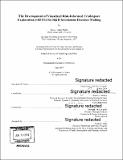The development of visualized risk-informed tradespace exploration (vRITE) for R&D investment decision-making
Author(s)
Mahle, Samuel Adam.
Download1117774805-MIT.pdf (22.82Mb)
Other Contributors
Massachusetts Institute of Technology. Institute for Data, Systems, and Society.
Technology and Policy Program.
Advisor
Donna H. Rhodes.
Terms of use
Metadata
Show full item recordAbstract
Uncertainty and risk are endemic in research and development (R&D) programs. Managing risks is a pivotal step at all phases of system design, but is particularly important at the beginning phases where system designers attempt to assess many design alternatives before the systems is developed and deployed. Designing systems that mitigate risks or are flexible enough to withstand them can lead to more reliable and valuable systems. If decision-makers believe the risks are too high, they may not invest in a technology that would provide the capabilities they need. Alternatively, if they underestimate the risks of a technology, investment may lead to costly and embarrassing overruns. Unfortunately, the existing approaches that decision-makers use to help them understand their options are often inadequate and do not tell the full story. In practice, overly simplistic methods can lead to arbitrary analysis, while more complex techniques such as NASA's probabilistic risk assessment procedure can be too costly and time-consuming for the fast-moving R&D context. These shortfalls can lead to results that decision-makers do not trust and ultimately ignore, leading to decisions based on gut-feelings or hunches. In addition to these shortfalls, there exist gaps between the theory upon which many decision methods and their results are based; several researchers have pointed out computational weaknesses in risk matrices, one of the most widely-employed risk assessment tools. Simply put, the decision-making tools that exist today may not be adequate. Moreover, many risk assessments are conducted secondary to initial tradeoff analysis, resulting in suboptimal design decisions that do not account for risks from the beginning. In R&D programs, decision-makers require a human-centric method of modeling and communicating the benefits, costs, and risks associated with various technologies. This research develops a framework for conducting Visualized Risk-Informed Tradespace Exploration (vRITE) based on insights gained from practicing R&D program managers. vRITE provides decision-makers an interactive, human-centric analysis of the cost, schedule, performance, and risk associated with multiple technologies. Two example vRITE analyses are used illustrate how the framework addresses the real-world objective and subjective considerations that decision-makers care about most and allows them to explore the data, helping them identify which technology warrants investment. The information provided in a vRITE analysis can reduce the barriers to R&D investment and ultimately lead to more risk-informed decision-making.
Description
Thesis: S.M. in Technology and Policy, Massachusetts Institute of Technology, School of Engineering, Institute for Data, Systems, and Society, 2019 Cataloged from PDF version of thesis. Includes bibliographical references (pages 145-151).
Date issued
2019Department
Massachusetts Institute of Technology. Institute for Data, Systems, and Society; Massachusetts Institute of Technology. Engineering Systems Division; Technology and Policy ProgramPublisher
Massachusetts Institute of Technology
Keywords
Institute for Data, Systems, and Society., Technology and Policy Program.